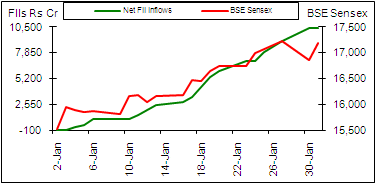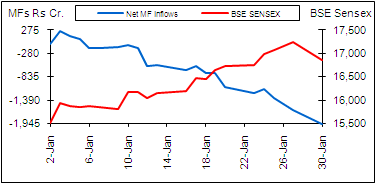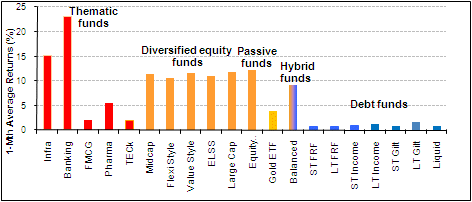Mutual Fund Roundup: January 2012
Market Overview
After eroding a quarter (i.e. 25%) of investors' hard earned savings in the year gone by, the year 2012 has started on positive streak for the Indian equity markets. In the last month i.e. January 2012, the BSE Sensex displayed a positive impulse by gaining good +11.2% despite the gloomy clouds of debt-overhang situation in the Euro zone still evident. In fact during the month gone by, the Indian equity markets decoupled despite downbeat news of France losing its prime rating of ‘AAA’ rating and being downgraded to ‘AA+’ by the Standard & Poor’s. It is noteworthy that, barring Germany, S&P axed sovereign rating of Italy and Spain by two notches (to ‘BBB+’ and ‘A’ respectively), and provided junk status to Cyprus and Portugal (rating them ‘BB+’ and ‘BB’ respectively), which again did not have a much detrimental impact on the Indian equity markets. While European leaders agreed to a permanent rescue fund for the Euro zone, and stricter budget discipline, the differences over austerity limits, and Greece's unfinished debt restructuring negotiations with private bondholders, hampered efforts to send a more optimistic message that Europe is getting on top of its debt crisis. Moreover, with unemployment rate in the Euro zone touching a creepy high of 10.4% (which is highest since the Euro was introduced a decade ago) brought in new challenges to the Euro Union leaders decree of creating new jobs and economic growth. The Euro zone continued to grow at a dismal rate of 0.2% in Q3 of 2011, as they confronted the situation of a debt overhang. Meanwhile the U.S. on the other hand witnessed a rise in its Q4 2011 economic rate as it clocked a GDP growth of 2.8% - a jump of good one percentage points from the GDP growth posted in the quarter before.
Speaking about India, the Government step to allow foreign individual investors, pension funds and trusts to directly invest in equities, provided an impetus to the Indian equity markets. This step was taken by the Finance Ministry to widen the investor class, attract more foreign funds, reduce market volatility and deepen the Indian capital market; which infused positive sentiments. Also with December 2011 WPI inflation mellowing to 7.47% (from its earlier mark of 9.11%), the markets respired a relief as it was getting close to comfort range (of 6.00% - 7.00%) of the Reserve Bank of India (RBI), and also nearing the fiscal year-end target of 7.00% set by the central bank. The sharp rise in the Index of Industrial production for November 2011 (data released in January 2012) to +5.9% (due to expansion of +6.2% in manufacturing index and robust growth of +13.1% in consumer goods) also attributed to an upswing in the Indian equity markets. The Q3 FY12 earning numbers thus far revealed were mixed, but with some prominent names such as ICICI bank, HDFC Bank, TCS and Infosys reporting appealing Quarter-on-Quarter growth in profitability, it added exuberance to the Indian equity markets. In the 3rd quarter review of monetary policy 2011-12 (held on January 24, 2012) the RBI once again pressed the pause button on policy rates. But since they addressed to the tight liquidity situation by the reducing the Cash Reserve Ratio (CRR), it flushed liquidity in the system which again was helped the markets show an impulse in the month gone by. Moreover with the central bank since November 24, 2011 buying Government securities aggregating to Rs 719 billion to solve the tight liquidity problem in the system also helped the Indian markets to pave an up-move.
While the Government’s borrowing target of Rs 4.7 trillion by March 2012 remained a concerned, it was rather in the intermediate ignored by the markets due to aforementioned positive economic news.
Speaking about the political scenario in India, since the focus turned to polls in the northern regions such as Punjab, Uttar Pradesh and Uttarakhand, the anti-graft campaign led by Mr Anna Hazare seemed to lose steam, as respective political parties eyed on share of votes.
The precious yellow metal – gold, after undergoing corrective phase in December 2011, in the month gone by, once again depicted an up-move swing after the end of Khar Mass (which is considered inauspicious month as per the Hindu calendar for gold buying and starting new ventures) on January 14, 2012. Moreover, stockist too piled up inventory to meet demand during the marriage season which also pushed prices up. Taking a cue of the fact that global economic uncertainties still remains, the gold in U.S. dollar term also gained by +7.4%, until data as on January 20, 2012, where price per troy ounce of was U.S. $ 1,653
Speaking about the Brent crude oil, prices surged as tensions between Iran and United States persisted over closure of Strait of Hormuz (which is a vital transit route for almost one-fifth of the oil traded globally), as it escalated supply worries.
For the bonds markets, the flush in liquidity due to reduction in CRR and Open Market Operations (OMO) purchase, helped to push down yields of 8.79% 2021 G-sec bonds. However the yields of 1-month and 3-month CDs hardened by 10 and 30 basis points (bps) respectively, thus taking them to 9.60% and 9.90% respectively.
Monthly Market Roundup
|
As on Jan 31, 2012 |
As on Dec 31, 2011 |
Change |
% Change |
| BSE Sensex |
17,193.6 |
15,454.9 |
1,738.6 |
11.2%  |
| S&P CNX Nifty |
5,199.3 |
4,624.3 |
575.0 |
12.4%  |
| CNX Midcap |
7,100.6 |
6,111.9 |
988.7 |
16.2%  |
Gold ( /10 gram) /10 gram) |
28,140.0 |
27,100.0 |
1,040.0 |
3.8%  |
| Re/US $ |
49.5 |
53.1 |
3.6 |
6.8%  |
| Crude Oil ($/BBL) |
110.5 |
108.3 |
2.1 |
2.0%  |
| 10-Yr G-Sec (%) |
8.28 |
8.57 |
(0.29) |
29 bps  |
| 1-Yr FDs |
7.25% - 9.40% |
(Monthly change as on January 31, 2012)
(Source: ACE MF, PersonalFN Research)
Enthused by the aforementioned domestic economic events, and considering the fact that Emerging Market Economic (EME) such as India is still offering luring growth, as compared to the Developed economies, Foreign Institutional Investors (FIIs) exuded confidence in the Indian equity markets and bought net to the tune of Rs 10,358 crore. This thus led to a greater acceleration from last month’s net buying activity where they bought net only to the tune of Rs 98 crore.
BSE Sensex vs FII inflows

(Source: ACE MF , PersonalFN Research)
Mutual Fund Overview
However, domestic mutual funds on the other hand turned net sellers in the Indian equity markets to the tune of Rs 1,947 crore, thereby snapping their last month’s buying activity worth Rs 580 crore. It seems that fund managers preferred to book profits in this impulsive move, and investors’ too favoured profit booking, as the markets delivered an appealing return of +11.2% in the last month.
BSE Sensex vs MF inflows

(Source: ACE MF, PersonalFN Research)
Tracing the upswing of the Indian equity markets, domestic equity mutual funds across categories performed in a very appealing manner. Amongst the diversified equity mutual fund schemes, both large cap as well as mid cap oriented provided luring returns. From a fund management style perspective, value style funds stood to gain due to earlier value buying opportunities availed by fund managers.
Amongst the sector funds, schemes focusing on the banking & financial services domain and infrastructure space provided very luring returns as a pause from RBI from increasing policy rates and a CRR cut (of 50 bps), helped the underlying stock in their portfolio to perform well.
In the Fund of Fund (FoF) schemes, the equity oriented got the benefit of the impetus in equity markets. International feeder funds too gained as the Indian rupee continued to remain under pressure against the U.S. dollar.
Speaking about the hybrid funds, balanced funds due to their dominant exposure towards equity, got a fillip on return, while Monthly Income Plans (MIPs) too benefited by a drop in yields of long-term papers.
Monthly top gainers: Open-ended equity funds
(1-Mth returns as on January 31, 2012)
(Source: ACE MF, PersonalFN Research)
Monthly top gainers: Open-ended Fund of Funds
(1-Mth returns as on January 31, 2012)
(Source: ACE MF, PersonalFN Research)
Monthly top gainers: Open-ended Hybrid Funds
(1-Mth returns as on January 31, 2012)
(Source: ACE MF, PersonalFN Research )
Monthly top gainers: Open-ended debt funds
(1-Mth returns as on January 31, 2012)
(Source: ACE MF, PersonalFN Research )
Debt mutual funds too across categories and tenure performed well in the month gone by, as two successive pauses in policy rate hikes, along with a flush in liquidity due to a CRR cut (of 50 bps) and purchase of Government securities (through OMO), helped easing the yield curve. However, debt mutual fund schemes focusing on holding longer maturity papers performed better aided by softening in longer tenure bond yields. Short-term debt funds continued to provide dismal returns due to stiff yields of short-term maturity papers, and yet tight liquidity condition. However, mutual fund net buying activity in the Indian debt market was far muted at Rs 13,242 crore, when compared to aggressive net buying net to the tune of Rs 52,285 crore in December 2011.
Performance across various categories of mutual funds

(1-Mth average returns of funds in various categories as on January 31, 2012)
(Source: ACE MF, PersonalFN Research)
The graph above depicts how various categories of mutual funds performed in the previous month. As revealed above, all equity funds across categories performed well, but banking & financial services sector funds and infrastructure funds provided stellar returns, as a pause from RBI from increasing policy rates and a CRR cut (of 50 bps), helped the underlying stocks in their portfolio to perform well. Amongst the diversified equity mutual fund schemes, both - large cap as well as mid cap oriented ones provided luring returns. From a fund management style perspective, value a style funds stood to gain due to earlier value buying opportunities availed done by fund managers. Debt mutual funds schemes took cue from RBI’s monetary policy action and delivered return across categories as cited above.
Other News and New Fund Offers
- Citing investor anxiety over the disclaimers flashed for the mutual fund investments, the Association of Mutual Funds in India (AMFI) - the industry body for mutual funds, is mulling ways to redraft the disclaimer - "mutual fund investments are subject to market risks. Please read the scheme information document carefully before investing."
The AMFI feels that such a disclaimer develops a fear psychosis in the minds of investors, which hinders in attracting new investors, and thus is of the view that disclaimer needs to be infused with positive flavour to encourage more investors to park their hard earned money in mutual fund schemes.
We believe that for instrument like mutual fund, which is closely linked with the capital market movement a disclaimer which reveals the risk of the investment instrument is very necessary. The capital market regulator - Securities and Exchange Board of India (SEBI) should ensure that unnecessary sweeteners aren't added in the disclaimer, which may tone the disclaimer in persuasive way, rather making the buyer of the instrument more aware. We are of the view that reporting norms for disclosure in fact sheets should be made more standardised, which can help investors to take more informed decision.
Moreover, we think that investors too should adopt a prudent approach to mutual fund investing. Remember while selecting winning mutual funds, you must do enough research, and if aren't equipped to do so must hire the services of a mutual fund expert who does that for you in a very unbiased way.
- The mutual fund industry’s average Assets Under Management (AUMs) for the quarter ended December 31, 2011 stood at Rs 681,708 crore as against Rs 7,43,719 crore for the quarter ended April to June 2011, thereby taking a dip of 8.3%. The decline in the AUMs occurred due to high redemption pressure faced in the liquid and income fund category (which saw net outflows to the tune of Rs 48,839 crore and Rs 15,401 crore respectively), due to withdrawal from corporates to meet their advance tax obligation, and banks adhering to RBI’s regulation of restricting their investment amount in mutual funds not exceeding 10% their net worth.
Equity funds’ AUM too fell by Rs 7,771 crore as redemption pressures were built in due to the nervous sentiments across the globe steered by Euro zone debt crisis and oil prices inching up.
Disclaimer: This note / article is for information purposes and Quantum Information Services Pvt. Limited (PersonalFN) is not providing any professional / investment advice through it. The recommendation service, views, articles and other contents are provided on an "As Is" basis by PersonalFN. The facts mentioned in the note are believed to be true and from a public source. The Service should not be construed to be an advertisement for solicitation for buying or selling of any scheme / financial product. PersonalFN disclaims warrants of any kind, whether express or implied, as to any matter/content contained in this note, including without limitation the implied warranties of merchantability and fitness for a particular purpose. PersonalFN and its subsidiaries / affiliates / sponsors / trustee or their officers, employees, personnel, directors will not be responsible for any direct/indirect loss or liability incurred by the user as a consequence of his or any other person on his behalf taking any investment decisions based on the contents of this note. Use of this note is at the user's own risk. The user must make his own investment decisions based on his specific investment objective and financial position and using such independent advisors as he believes necessary. PersonalFN does not warrant completeness or accuracy of any information published in this note. All intellectual property rights emerging from this note are and shall remain with PersonalFN. This note is for your personal use and you shall not resell, copy, or redistribute this note, or use it for any commercial purpose. Please read the terms of use.
Add Comments
| Comments |
jimstroud@jimstroud.com
Jun 17, 2012
Hello Blogger! I discovered your webitse on Google and as an SEO specialist I have a tip for you that I think you will find very useful. There's a WordPress Plugin that automatically does SEO for your webitse for better rankings, it's a 1-click setup that's not expensive at all and will help you make more money and drive more traffic to your blog. Click my username to take a look. Thanks for reading. |
1